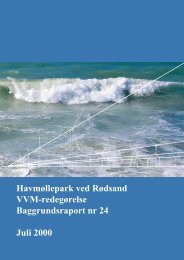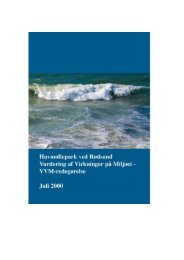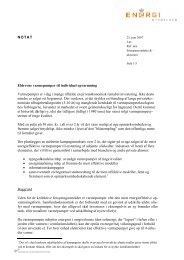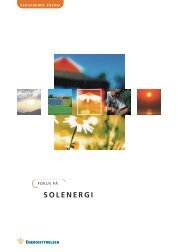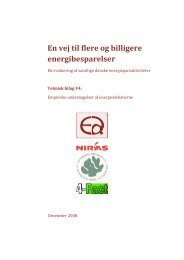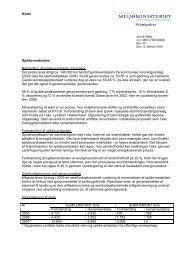Havmøllepark ved Rødsand VVM-redegørelse Baggrundsraport nr ...
Havmøllepark ved Rødsand VVM-redegørelse Baggrundsraport nr ...
Havmøllepark ved Rødsand VVM-redegørelse Baggrundsraport nr ...
Create successful ePaper yourself
Turn your PDF publications into a flip-book with our unique Google optimized e-Paper software.
North Atlantic over to Novaja Zemlya. The<br />
populations in the northeastern Atlantic was<br />
estimated at 1.1 million Razorbills, 5.6 million<br />
Guillemots and 275,000 Atlantic Black Guillemots<br />
(Laursen et al. 1997)<br />
Moult, migration and wintering<br />
Alcids moult their flight feathers simultaneously<br />
and are thus flightless during progression of<br />
feather renewal, which probably takes 40-50<br />
days and occurs during August-November.<br />
Outside the breeding season Razorbill and Guillemots<br />
may disperse over a vast range in the<br />
North Atlantic to either moult or winter.<br />
Occurrence in Danish waters<br />
The breeding populations of Razorbill and Guillemot<br />
are confined to Ertholmene whereas Black<br />
Guillemot breeds exclusively in the Kattegat and<br />
Great Belt area. Outside the breeding season<br />
conspicuous movements of Razorbill and Guillemot<br />
from the north Atlantic to Danish waters<br />
occur. During the summer, a substantial moult<br />
migration of c. 200,000 Guillemots occurs in<br />
Skagerrak and the northern part of Kattegat<br />
(Laursen et al. 1997). During autumn, Razorbills<br />
occur in large numbers in Kattegat as Guillemots<br />
also disperse further south in Kattegat and<br />
down the west coast of Jutland. In the 1980s,<br />
the autumn populations in Kattegat were estimated<br />
at 49,000-165,000 Razorbills and 30,000-<br />
45,000 Guillemots compared to 7,000-31,000<br />
Razorbills and c. 200,000 Guillemots in the North<br />
Sea. Winter estimates of up to 290,000 Razorbills<br />
in Kattegat and 120,000 in the North Sea<br />
have been obtained. For Guillemots the winter<br />
estimates amounted to 120,000 in the North Sea<br />
and 175,000 in Kattegat. At least in the late 1980s<br />
notable numbers of wintering Black Guillemots<br />
were counted around Læsø (720-2,150). During<br />
severe winter up to 12,000 Baltic Black Guillemots<br />
C. g. grylle were obser<strong>ved</strong> mainly on Rønne<br />
Banke. However, Baltic Black Guillemots were<br />
also found in Fehmarn Belt. On at least two occasions<br />
during autumn and winter more than<br />
100,000 alcids have been obser<strong>ved</strong> at the east<br />
coast of Djursland in one day (Olsen 1992).<br />
74<br />
Food<br />
The diet mainly comprises fish, e.g. sand-eel<br />
Ammodytidae, Herring Clupea harengus and Sprat<br />
Sprattus sprattus and in shallow water (mostly<br />
Black Guillemot) e.g. Butterfish Pholis gunnellus,<br />
gobies Gobiidae and Blennies Zoarces viviparus.<br />
Behaviour<br />
Alcids are gregarious throughout the annual<br />
cycle and breed in dense colonies which may<br />
comprise several thousand nests. The fact that<br />
alcids undergo simultaneous wing moult could<br />
suggest that they are extraordinarily sensitive<br />
to disturbance during this period.<br />
Status and conservation<br />
Compared to the overall north Atlantic populations<br />
the breeding populations in Denmark are<br />
small. In fact, Razorbill is on the Danish red-list<br />
for the same reason (Stoltze & Pihl 1998b). Little<br />
is known about trends in population sizes.<br />
However, the numbers of Razorbills occurring<br />
in Danish waters are of international importance<br />
as potentially up to 36% and up to 15% of the<br />
north Atlantic population occur in Kattegat and<br />
the North Sea, respectively (Laursen 1997).<br />
Therefore, Razorbill was yellow-listed (Stoltze<br />
& Pihl 1998a).<br />
Woodpigeon Columba palumbus - Ringdue<br />
Breeding<br />
Woodpigeon breeds in all kinds of woodland<br />
all over Europe and western Russia. In Denmark<br />
the population of wood pigeons has been estimated<br />
at 291,000 pairs (Jacobsen 1997). In Sweden<br />
no national estimate is available. However,<br />
up to 200,000 individuals per year were recorded<br />
on autumn migration at Falsterbo (Risberg<br />
1990).<br />
Moult, migration and wintering<br />
Woodpigeon has sequential wing moult. Hence,




